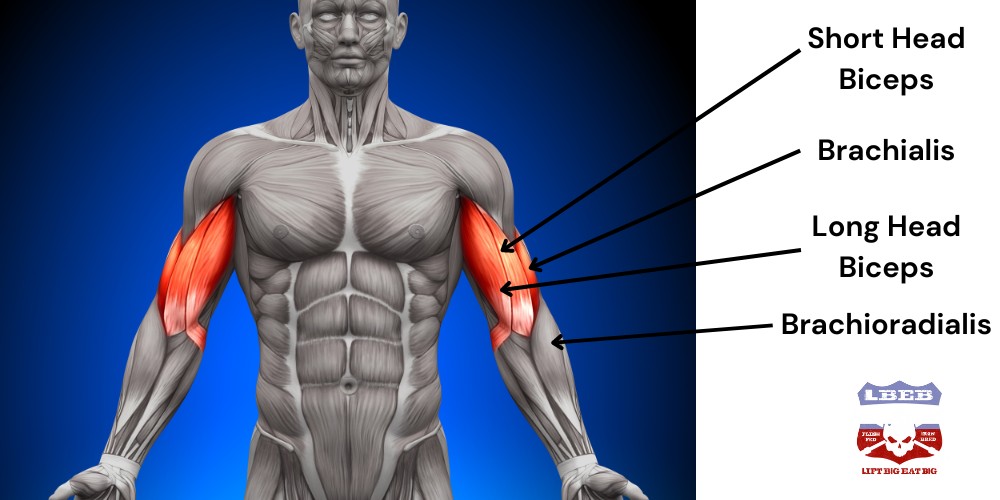I haven’t come across a more hated exercise than the plank. It’s equally as useless, but that’s a post for another time. Before your core gives out, your arms and shoulders burn as you struggle to hold your body perfectly still. Does that mean the plank works your biceps?
While planks are challenging for the arms and shoulders, it does not work the biceps significantly to build them.
But why doesn’t the plank work the biceps, and what about other plank variations? To understand why not, we must know basic biceps anatomy.
Table of Contents
Biceps Anatomy
The biceps brachii are made of two muscle heads:
- Short head
- Long head

Both heads originate at the shoulder and insert on the radius bone in the outer forearm [1]. The primary function of the biceps is to flex the elbow and supinate the forearm. They also help flex the shoulder. The biceps brachii elicit the greatest muscle activation when the forearm is supinated.
But two other muscles are lumped into the biceps group because they perform elbow flexion. The brachialis and brachioradialis. They are targeted with different hand positions.
The brachialis originates on the bottom of the upper arm and inserts on the ulnar bone in the inner forearm. It has the primary function of flexing the elbow [2]. It’s the strongest elbow flexor. Even stronger than the biceps brachii.
A neutral hand position targets the brachialis, so exercises like the hammer curl. The brachioradialis contributes to elbow flexion and pronates and supinates the forearm. The most significant activation occurs when performing curls with a pronated hand position [3]. Exercises like the reverse curl targets this muscle.
Does the plank perform any of the biceps functions?
Do Planks Work Biceps?
Planks don’t work the biceps significantly as elbow flexion is not loaded. When performing the plank on your forearms, your shoulders support your bodyweight. Your biceps may be contracted to create full body tension, but it is an isometric contraction with no load.
Essentially, you’re flexing the biceps, not working them. Further, the isometric contraction is at a short muscle length which is inferior to long muscle length isometrics [4].
To train your biceps, you need to perform elbow flexion through a full range of motion to maximize mechanical tension on the muscle. Planks don’t do this and, therefore, don’t work your biceps.
Does The Straight Arm Plank Work Biceps?
The straight-arm plank is an easier plank variation where you hold the top of a push-up position. But this doesn’t work the biceps either. The shoulders and triceps support your bodyweight. The biceps act as a stabilizer muscle, but there is no change in muscle length.
Do Planks Make Your Arms Bulky?
Planks will not make your arms bulky. You must target heavy compound pressing exercises with lighter elbow extension exercises to get bigger triceps. To build bigger biceps, you must target heavy compound pulling exercises with lighter elbow flexion exercises.
The plank involves none of these movements to target the biceps or triceps and, therefore, will not give you big, bulky arms.
Summary
The plank doesn’t work the biceps enough to grow them. There is little to no tension placed on them, and they are stuck in a short muscle length isometric which is inferior for muscle growth. If you want bigger biceps, use various curls with different hand positions.
References
1. Tiwana, M. S., Charlick, M., & Varacallo, M. (2018). Anatomy, shoulder and upper limb, biceps muscle.
2. Plantz, M. A., Bordoni, B. (2022). Anatomy, Shoulder and Upper Limb, Brachialis Muscle.
3. Kleiber, T., Kunz, L., & Disselhorst-Klug, C. (2015). Muscular coordination of biceps brachii and brachioradialis in elbow flexion with respect to hand position. Frontiers in physiology, 6, 215.
4. Oranchuk, D. J., Storey, A. G., Nelson, A. R., & Cronin, J. B. (2019). Isometric training and long‐term adaptations: Effects of muscle length, intensity, and intent: A systematic review. Scandinavian journal of medicine & science in sports, 29(4), 484-503.
